Aperture's Blog, page 166
February 9, 2015
Geoff Dyer & Janet Malcolm: On Photography, Writing, and Aircraft Carriers
The following conversation first appeared in Aperture magazine #217, Winter 2014, “Lit.” Subscribe here to read it in full, in print or online.
Of the influential British art critic and novelist John Berger, writer Geoff Dyer deems most striking Berger’s “ability to keep looking, staring at a picture until it yields its secrets.” Dyer’s comment appears during the following exchange with critic Janet Malcolm. Dyer and Malcolm, two distinguished writers on photography, were drawn to the medium for different reasons. Although Malcolm suggests that they may even reside within different rooms in photography’s many mansions, both agree that good writing on images begins with an urge to “keep looking.
Malcolm is a longtime staff writer for the New Yorker and a force in American writing and journalism. She is the author of more than ten books, which include Diana & Nikon: Essays on the Aesthetic of Photography (1980); The Journalist and the Murderer (1990); The Silent Woman: Sylvia Plath and Ted Hughes (1994); Two Lives: Gertrude and Alice (2007); and Iphigenia in Forest Hills: Anatomy of a Murder Trial (2011). Her recent collection Forty-One False Starts: Essays on Artists and Writers (2013) includes, among other pieces, writings on Diane Arbus and Thomas Struth and a brilliant 1986 portrait of Artforum then-editor Ingrid Sischy, and demonstrates that, no matter the subject, Malcolm’s approach is analytical and precise, almost photographically so.
Geoff Dyer is equally catholic in his selection of topics, usually approached in a pleasurably digressive style entirely his own. His book about photography, The Ongoing Moment (2005), is organized around various photographers’ handling of subjects, from blind individuals to hats to benches. Dyer warns his readers in the book’s introduction: “I suspect that this book will be a source of irritation to many people, especially those who know more about photography than I do.” Surely even the most informed readers benefited from his unique approach. Dyer’s other books include Out of Sheer Rage (1997), an achingly funny book about not writing a book about D.H. Lawrence; an essay collection titled Otherwise Known as the Human Condition (2011, winner of a National Book Critics Circle Award for Criticism); Zona (2012), about Andrei Tarkovsky’s film Stalker; and most recently, Another Great Day at Sea: Life Aboard the USS George H.W. Bush (2014).
When Aperture asked Dyer and Malcolm this past summer to correspond about their respective practices as writers who share an abiding interest in photography, the ensuing email exchange took place over a number of weeks, with Dyer corresponding from his temporary residence in Venice, California, and Malcolm from her summer home in rural Massachusetts. The conversation is fittingly interrupted at one point by a summer storm; an impasse is overcome, improbably, by a surprisingly relevant discussion of aircraft carriers. Dyer and Malcolm may not reveal any secrets as to how they both so precisely bring their subjects into sharp focus. Indeed, there may be none to reveal— aside from a preternatural talent for translating close looking into shrewd writing.
- The Editors

Tamara Shopsin & Jason Fulford, photo-illustration (after Kenneth Josephson), 2014
Geoff Dyer: How did you first become interested in photography? Did this interest precede your writing about it or did the two things occur more or less simultaneously? At the risk of preempting your answer, at what point did an interest in photographs or photographers become an interest in photography?
Janet Malcolm: Like Julia Margaret Cameron, I became interested in photography when a relative gave me a camera. Unlike Mrs. Cameron, I did not become a great photographer, or even a good one. I learned no technique. Most of the pictures I took were either under- or overexposed. Chance dictated that some images emerged clearly. But I loved taking pictures and would take the camera—a Leica M3—on all trips.
I had read that Cartier-Bresson thought of his Leica as an extension of his eye, considering it a great improvement over the large, heavy cameras that were its predecessors. It permitted him to run around Paris having his decisive moments. It has taken me years to realize that (1) traveling with a camera and seeing everything through its eye rather than through one’s own may not be the best way to see the world, and (2) the Leica is not a lightweight object but a heavy, cumbersome thing when compared to the deliciously lightweight point-and-shoot and cellphone cameras of today.
I began writing about photography with the spurious authority of the young. I probably thought that my experience as an amateur photographer was some sort of qualification. Above all, I was inspired by John Szarkowski’s brilliant directorship of the Museum of Modern Art’s photography department and by his book Looking at Pictures. What about you? How did you come to write about photography? What drew you to it?
GD: Almost entirely it was reading about it (rather than actually looking at pictures). The big three: you know, two Bs and an S—Barthes, Berger, and Sontag—and a bit of a third B: Benjamin. I wrote a few small things on photographers for British papers and then I became very interested in photographs of jazz musicians when I was writing But Beautiful in 1989, particularly in the question of whether, or how, to convey sound visually. But I was using the pictures mainly as a source for fiction so was far more concerned with the people in the pictures than I was with the people who took them, something I became interested in only later. (That happened when I realized that a picture of D.H. Lawrence was also a picture by Edward Weston.) I still think jazz is an art form that’s been very well served by photography. Do you know Roy DeCarava’s amazing picture of Ben Webster and John Coltrane?
JM: No, I don’t.
GD: I didn’t know it at the time I was writing But Beautiful but wish I had, especially since DeCarava, in The Sound I Saw, had very consciously explored the question that interested me. Webster is cuddling him—Coltrane!—with such rough tenderness. There it is: tradition in jazz condensed into a single picture. I still love it—it’s so intimate and telling—even though DeCarava turned out to be impossible about having his pictures reproduced in The Ongoing Moment. That’s a subject—the right to reproduce images—I’m sure we’ll want to come back to. Anyway, my knowledge of photography was still very scanty in the early 1990s. I remember going to dinner at John Berger’s place in the Paris suburbs in 1991. Cartier- Bresson was there. The name rang some kind of bell but I wasn’t sure if he was a film director or a maker of watches. In 1997 I was invited to the Center for Documentary Studies in Durham, North Carolina, to help work on a book of photographs by William Gedney that Margaret Sartor was putting together. That’s when I became aware of how incredibly ignorant I was about the history of photography and began to study it in a far more thorough way. Perhaps appropriately that’s when and where I first read your book Diana & Nikon. I only read Szarkowski much later, by which time I had a sense of what a huge figure he was. I read and reviewed his Atget book—the one with a picture on one page and a few paragraphs of text on the facing page—which I think is one of the great books about photography and a beautiful work of art. (Incidentally, I hope I won’t go to my grave without having done a similar kind of book—picture on verso page, text on recto or vice versa—myself.) He saw the review and sent me a signed copy of his book Mr. Bristol’s Barn. Obviously that’s something I treasure. Anyway, going back to what I said at the beginning, I’d be very interested to hear what Berger, Barthes, and Sontag—each of them— meant to you.
JM: I had to smile when I read your reply to my question. Aperture could not have brought together two people who are more apart in their relationship to photography than we are. Berger’s, Barthes’s, and Sontag’s writings on photography have meant almost nothing to me. I struggled and failed to grasp Barthes’s and Berger’s thought, and while I could understand Sontag’s, with a few exceptions (the Leni Riefenstahl piece, for example), I found her interests remote from mine.
The house of photography has many mansions, and you and I live in different parts of the building. You are on a high floor with a large view while I am in the garden apartment. The first publisher of Diana & Nikon gave the collection the rather clumsy subtitle “Essays on the Aesthetic of Photography.” But what he had in mind was to distinguish my approach from Sontag’s. These are conceptual writers, while I am—I don’t know—someone who is better equipped to look at pictures than to think about what photography is.
So what are we going to talk about—aircraft carriers perhaps? I read your piece in the New Yorker about your experiences aboard one of those amazing vessels with the most enormous pleasure and admiration. I have been interested in aircraft carriers ever since I read a book called We Captured a U-Boat by Rear Admiral Daniel V. Gallery, in which an aircraft carrier called the Guadalcanal subdues a German submarine and tows it 1,700 miles back to America. The submarine is now in a museum in Chicago. Did you read this book in preparation for your project? I’m not sure why, but I think aircraft carriers will help get us over our impasse re: photography.
(Conversation continues.)
Read the full conversation in Aperture magazine #217, Winter 2014, “Lit.”
The post Geoff Dyer & Janet Malcolm: On Photography, Writing, and Aircraft Carriers appeared first on Aperture Foundation NY.
Aperture Summer Open Call for Entries is now Open!
The call for entries is now open for the 2015 Summer Open, Aperture’s second open-submission exhibition for which all photographers are eligible. Entries for the 2015 Aperture Summer Open will be accepted until Wednesday, April 8, 2015, at 12:00 noon eastern time.The theme for this year’s Summer Open is Black Mirror. The show will be curated by Aperture magazine editor Michael Famighetti.
Entry requirements have changed for 2015 in response to Member and magazine subscriber feedback. Entrants must now be current Aperture Foundation Members through April 10, 2015, OR an Aperture magazine print subscriber through the Summer issue, or #219.
For more information or to enter, click here.
The post Aperture Summer Open
Call for Entries is now Open! appeared first on Aperture Foundation NY.
February 5, 2015
Call for entries: Fondation Henri Cartier-Bresson’s HCB Award 2015
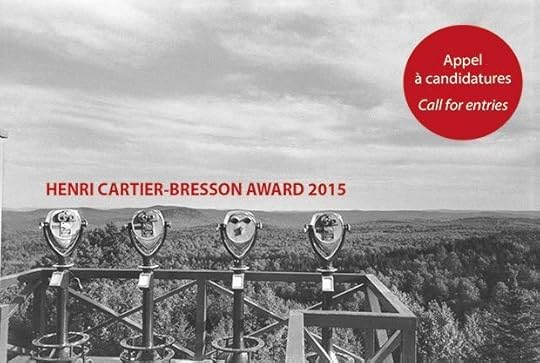
Fondation Henri Cartier-Bresson is now accepting applications for the biannual HCB Award, presented in partnership with Aperture Foundation, from now until April 30. The HCB Award is 35,000-euro prize for photographers who have completed a significant body of work with an approach close to that of documentary. Candidates should be nominated by an institution (museums, galleries, independent curators, publishers). Find rules for entry here and more information on the prize here.
Eighteen months after the reception of the prize, the winner will have an exhibition of his work at the Fondation HCB in Paris and a catalogue will be published. The prize-winner will be announced in June 2015 by an international jury. Past recipient include Chris Killip in 1989 and Josef Koudelka in 1991. The HCB Award is made possible with the partnership of the Fondation d’entreprise Hermès.
The post Call for entries: Fondation Henri Cartier-Bresson’s HCB Award 2015 appeared first on Aperture Foundation NY.
February 4, 2015
Remembering Robert Anthoine (1921-2015)
By Melissa Harris
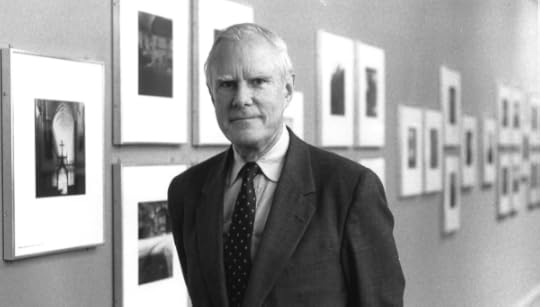
Dear, kind, generosity of spirit, fun, good-natured, always smiling, supportive, lovely, vivacious, joyful . . . the endearments are endless for Robert Anthoine, lawyer, teacher, and arts philanthropist who died on January 23, 2015, at age ninety-three.
Bob Anthoine served on the Board of Aperture Foundation, including as its chairman, for more than twenty years, from 1984 to 2008. After learning of his death, I wrote to generations of the Aperture family—a loyal and loving group scattered throughout the world. I knew that Bob had impressed so many of us, over so many years, with his warmth and intelligence. I wanted to let his larger family know of his death, so that we might all, in our own way, celebrate his life. When I wrote to his eldest daughter Alison Anthoine, she responded, “He had a very full life, with an unbounded enthusiasm for the arts, and a special relationship with Aperture. In a certain way, it was a kind of family for him. He would tell me the goings on there in much the same way I would tell him about my kids.” The feelings were entirely reciprocal.
Bob truly believed in certain projects, certain artists. He believed in freedom of expression. It was clear that he loved Aperture. Maybe it was our kookiness, for sure it was our executive director and publisher at the time, Michael E. Hoffman, and maybe it was also Bob’s belief that mission-driven, arts-oriented, not-for-profits should thrive. . . . He gave an enormous amount of his time and energy to help ensure that Aperture would survive. He was behind the formation of the Strand Foundation, which evolved out of Michael Hoffman’s friendship with Paul and Hazel Strand, and drove its ultimate merger with Aperture Foundation. He was also a constant sounding board for Michael—no matter where Bob was on the planet. Bob adored traveling—to call him peripatetic is an understatement. Yet there were certain nonnegotiable dates: I had the pleasure of spending many a Fourth of July with him and his second wife Rebecca Rudnick (who died in a scuba diving accident in 2001) and Michael—and it was 24/7 Wimbledon. Tennis was key (he was the Maine State tennis champion when he was in high school). Bob, who loved James Joyce, maybe even more than tennis, would regale us with his and Rebecca’s Bloomsday exploits in between matches: they often participated in the annual celebration in Dublin.
Bob was crazy for the theater—his missives from London were especially memorable. His support of the Royal Shakespeare Company by, among other things, creating the American Friends of the RSC, led to his appointment as an Honorary Governor for Life.
Although always engaged and ebullient, I’m not sure I ever saw Bob happier than when I told him I was working with Dario Fo on a book project. Fo’s humor, politics, irreverence, and brilliance as a playwright and performer made Bob giddy. I don’t know what was more fun—attending Fo’s performance, or watching Bob watching Fo perform! His laughter was wonderful!
Born in Portland, Maine, on June 5, 1921, Bob was the only child of Edward and Sara (Pinkham) Anthoine. After graduating from Duke University in 1942, he served for four years as a Lieutenant in the U.S. Navy. He graduated from Columbia Law School in 1949 and returned there to teach in 1952. In 1963, he joined Winthrop, Stimson, Putnam & Roberts as the head of its tax department. He continued to teach as an adjunct at Columbia for another thirty years, and as a visiting professor at law schools around the world through his seventies.
Among the many other organizations to which he devoted his time are the Morris Graves Foundation, the Eric and Salome Estorick Collection of Italian Art, and Volunteer Lawyers for the Arts; he cofounded (and was founding Chairman) the Lucid Art Foundation with painter Gordon Onslow Ford and artist/scientist Fariba Bogzaran, to support artists who explore the concept of arts and consciousness.
He is survived by his wife Margarita Maria Anthoine, whom he married in 2006, and his four children—Alison, Robert Neal, Nelson, and Nina Anthoine; as well as a step-daughter, Mary Danielle Hamilton-Russo; and, six grandchildren and two step-grandchildren.
A memorial celebrating Robert Anthoine’s life will be held on Monday, April 20 at 6:30-8:30 Aperture Gallery in New York City.
Melissa Harris is editor-in-chief of Aperture Foundation
The post Remembering Robert Anthoine (1921-2015) appeared first on Aperture Foundation NY.
February 3, 2015
Amy Elkins and Jona Frank at De Soto Gallery
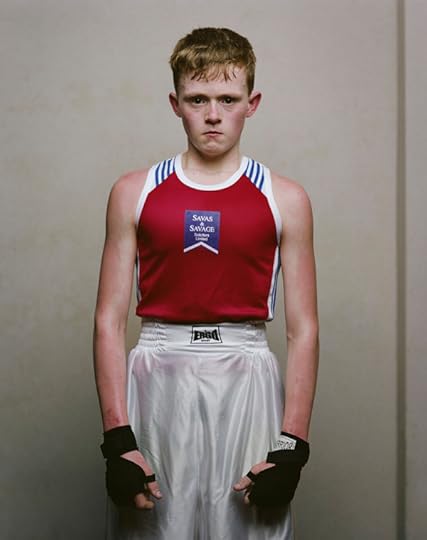

Jona Frank, James, Wirral Boxing Club, 2013

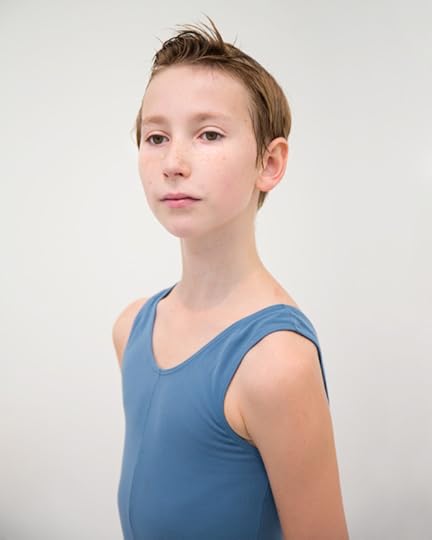
Amy Elkins, Ludwig, Age 12, 6th year in the Royal Danish Ballet School, 2012. Courtesy of the artist and De Soto Gallery

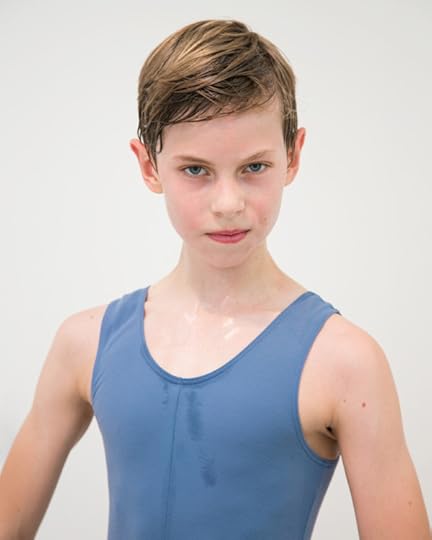
Amy Elkins, Lucas, Age 12, 6th year in the Royal Danish Ballet School, Copenhagen, 2012. Courtesy of the artist and De Soto Gallery

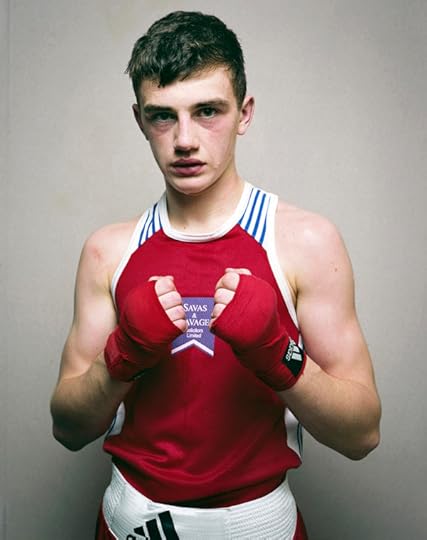
Jona Frank, Kyle, Wirral Boxing Club, 2013
An exhibition of photographs by Amy Elkins and Jona Frank at De Soto Gallery juxtaposes images of boy dancers and boxers, as the show’s title suggests, “In Position.” The show examines these small slices of life within specialized sports, as both photographers seek to pinpoint the disciplines’ particular physicality and traditions among young men. Elkins’s photographs come from her Danseur project, in which she documents Danish dancers studying with the top academies, the Royal Danish Ballet and Danse Hallerne. Frank has chosen young boxers as the subject for The Modern Kids, taken at gyms in Northern England.
Ballet represents a high-class entertainment typically embodied by women, while boxing is typically seen as a more masculine, lower class pursuit– but the images, together, aim to present a unified image of young masculinity among those whose bodies define their pursuit, or their art. Both sets of photographs offer alternately vulnerable and defiant portraits of young men wearing the signs and scars of their sport: A boy dancer’s pale blue leotard is dappled with sweat; a young muscular boxer peers out at us certainly from a half-closed black eye. The photographs catch glimpses of the athletes on the edge of adulthood, capturing every detail: from sweat to freckles to a sly smirk with precise detail. Moreover, the portraits present a take on male identity as captured by female photographers. Frank and Elkins (whose “Black is the Day, Black is the Night,” just finished its run at Aperture’s gallery this week) here offer a contemporary look at how young men express themselves both in their physical pursuits and in front of the camera.
“In Position” runs through February 28 at De Soto Gallery, in Venice, California.
The post Amy Elkins and Jona Frank at De Soto Gallery appeared first on Aperture Foundation NY.
January 22, 2015
War photographers and reporters on “Telling Afghanistan”
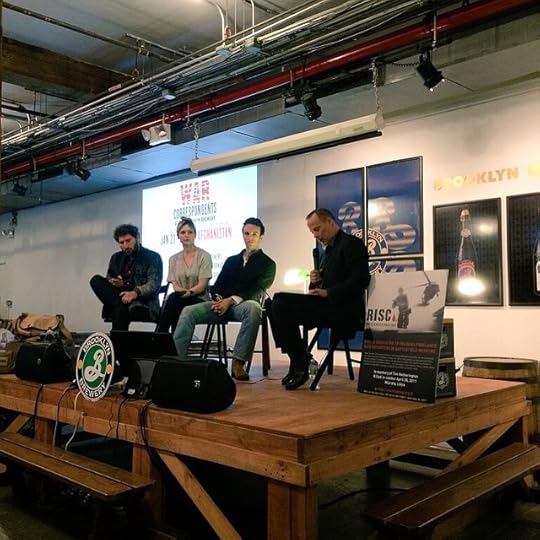
On Wednesday night at the Brooklyn Brewery, a group of photographers and reporters held up a mirror to how and why they report in conflict zones around the world, namely the war in Afghanistan. The panel, moderated by journalist and Restrepo director Sebastian Junger, included novelist and veteran Elliot Ackerman (Green on Blue), reporter Jennifer Percy (Demon Camp), and Magnum photographer Peter van Agtmael (Disco Night Sept. 11). The event was held by Reporters Instructed in Saving Colleagues (RISC), founded after the death of photojournalist Tim Hetherington in Libya in 2011. Though focused on Afghanistan, the panel offered a window into how conflict reporters grapple with the complicated consequences of working in the midst of war.
Junger opened the panel by asking if there’s an inherent attraction to war among those who cover it. Ackerman, who served five tours in Iraq and Afghanistan and drew from his time there to write his new novel, explained the drive to be in extreme situations. “That sense of purpose is like meth,” said Ackerman of young soldiers and journalists in war, who are, “freebasing the crystal meth of purpose.” When it came to attacks, he added, “My biggest fear was that I wouldn’t be there.” Van Agtmael offered perspectives on gathering images in dangerous conditions. “It’s something I can believe in besides its complications,” he said. “Photojournalism is an instinctual path.” Percy spoke about her experience reporting her new book, which tracks the residual effects of war, such as post-traumatic stress disorder. “There’s always that artifice,” she said about her time in the field, “being a spectator, a reporter.”
Van Agtmael offered an anecdote about sending the first edits of his book to a friend, who charged that he had too narrowly focused on American troops. “You see a slender reality as a photographer,” van Agtmael said. “That’s what I had access to, but I was filled with shame that she was right.” The panelists also compared experiences from Iraq and Afghanistan, and embedded versus unembedded reporting in war zones. Van Agtmael described embedded life as being part of “Little America.” Ackerman asked, “Why was I there in the first place? The answer has nothing to do with the political,” later adding, “I regret that I had to make that choice.”
Tickets to the event benefitted RISC to continue training freelance journalists to prepare for potentially fatal situations, free of charge. More information can be found on the RISC website. A video presentation of the event will run on Slate next week.
The post War photographers and reporters on “Telling Afghanistan” appeared first on Aperture Foundation NY.
War photographers and reporters on “Telling Afghanistan” at the Brooklyn Brewery

On Wednesday night at the Brooklyn Brewery, a group photographers and reporters held up a mirror to how and why they report in conflict zones around the world, namely the war in Afghanistan. The panel, moderated by journalist and Restrepo director Sebastian Junger, included novelist and veteran Elliot Ackerman (Green on Blue), reporter Jennifer Percy (Demon Camp), and Magnum photographer Peter van Agtmael (Disco Night Sept. 11). The event was held by Reporters Instructed in Saving Colleagues (RISC), founded after the death of photojournalist Tim Hetherington in Libya in 2011. Though focused on Afghanistan, the panel offered a window into how conflict reporters grapple with the complicated consequences of working in the midst of war.
Junger opened the panel by asking if there’s an inherent attraction to war among those who cover it. Ackerman, who served five tours in Iraq and Afghanistan and drew from his time there to write his new novel, explained the drive to be in extreme situations. “That sense of purpose is like meth,” said Ackerman of young soldiers and journalists in war, who are, “freebasing the crystal meth of purpose.” When it came to attacks, he added, “My biggest fear was that I wouldn’t be there.” Van Agtmael offered perspectives on gathering images in dangerous conditions. “It’s something I can believe in besides its complications,” he said. “Photojournalism is an instinctual path.” Percy spoke about her experience reporting her new book, which tracks the residual effects of war, such as post-traumatic stress disorder. “There’s always that artifice,” she said about her time in the field, “being a spectator, a reporter.”
Van Agtmael offered an anecdote about sending the first edits of his book to a friend, who charged that he had too narrowly focused on American troops. “You see a slender reality as a photographer,” van Agtmael said. “That’s what I had access to, but I was filled with shame that she was right.” The panelists also compared experiences from Iraq and Afghanistan, and embedded versus unembedded reporting in war zones. Van Agtmael described embedded life as being part of “Little America.” Ackerman asked, “Why was I there in the first place? The answer has nothing to do with the political,” later adding, “I regret that I had to make that choice.”
Tickets to the event benefitted RISC to continue training freelance journalists to prepare for potentially fatal situations, free of charge. More information can be found on the RISC website. A video presentation of the event will run on Slate next week.
The post War photographers and reporters on “Telling Afghanistan” at the Brooklyn Brewery appeared first on Aperture Foundation NY.
January 21, 2015
Liz Deschenes at the Walker Art Center
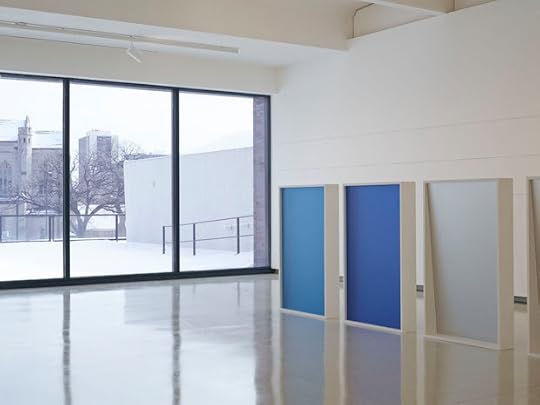




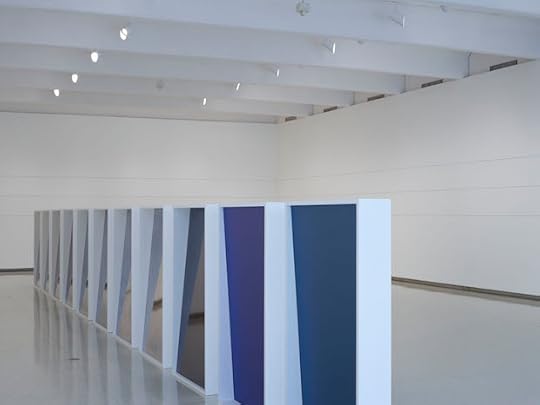

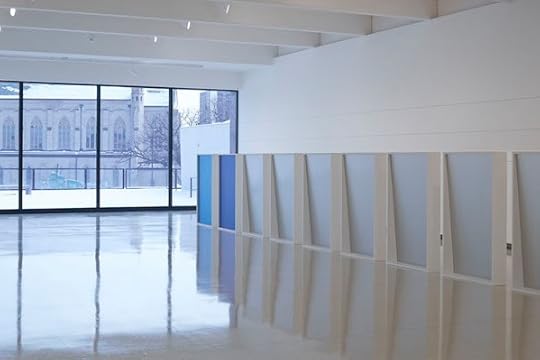

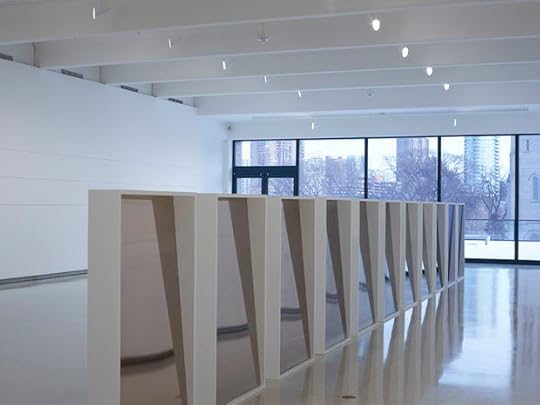

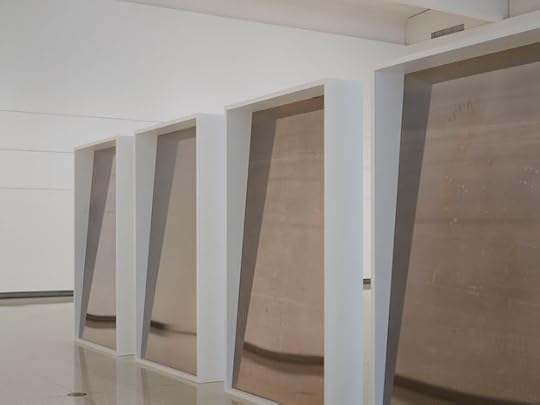
All photographs: Installation view, Liz Deschenes: Gallery 7. Photo: Gene Pittman, 2014. Courtesy the Walker Art Center, Minneapolis.
Liz Deschenes’s works exist as photographic objects and understanding of its realization at once. During the last three decades, Deschenes has sought to expand what defines the viewing of a photograph, her work inhabiting a space between image and sculpture. Over the years she has pared down the photograph to its most basic elements– paper, light, and chemical– and amplified them. Now, for a yearlong exhibition occupying the Walker Art Center’s seventh-floor gallery, Deschenes presents a large-scale installation, or “photographic intervention.” Of her work in the 2010 Whitney Biennial, she told BOMB Magazine, “What I am responding to is that photography is a translation of color and tones—a language.” Her aims are more abstract than traditional photography, she explained, often to “enable the viewer to see the inconstancy of the conditions of display, which are always at play but sometimes hard to see.”
In this most recent project, she shifts the contours of the room by letting in natural light and reorienting the layout with rectangular, colored panels, which consist of a combination of silvery photograms and digitally printed blue monochromes. She creates these photograms using a method for which she has become well known, in which she makes use of dim nighttime light on photosensitive paper, to be later washed with silver toner. Much like her new layout of the exhibition space itself, the result of the photograms depends on subtle shifts of light across space, here across surfaces. The other panels represent newer experiments with digital pigment printing on acrylic in various shades of blue. It’s an intervention in that the display’s parts alternately take in and reflect light, same as they intend to rearrange our movements. In that vein, Deschenes uses not just the materials of photography but also its usual setting for viewing– the show title, “Gallery 7,” is the original 1971 name for the gallery space, now called the Medtronic Gallery.
“Gallery 7″ is on view at the Walker Art Center, in Minneapolis, MN, through November 22.
The post Liz Deschenes at the Walker Art Center appeared first on Aperture Foundation NY.
Matt Johnston on the Photobook Club
My interest and inquiry into photobooks truly began only five or so years ago. Martin Parr, Gerry Badger, and co. had already helped to further (or establish or even destroy, depending on who you spoke to) the economic and cultural value of the photobook, yet I was frustrated with the available discourse. So many works were highly regarded and touted as masterpieces with little thought of genuine discussion. I started the Photobook Club online as a platform for these discussions: a place to ask why The Americans is important, or what exactly it is about Yukichi Watabe’s A Criminal Investigation (2011) that merits a third printing in as many years.
It was evident early on, however, that these discussions of tactile and personal experiences did not always translate well to a digital space. This is not to say we cannot write about bookworks online, but that, for many, the informal round-table discussion of a traditional book group is both more encouraging and more responsive. With this in mind, I ran meet-ups at the university at which I teach, as well as outside the academy in London. As a testament to the desire for this sort of interaction, with support new groups started to form in cities all over the world.
It is within this large and engaged network that I have sent out two boxes of photobooks (one in 2013 and the other in 2014), received and passed on by any clubs or communities who have requested a stopover. The idea is to connect sometimes geographically distant communities through common works—in this case, a selection of chosen books. The distributed authorship of the Photobook Club project means that ownership and responsibility rests with individual groups, which is wonderful for diversity and creativity. I have noticed, however, that sometimes these groups can become satellites rather than nodes, working as standalones rather than seeing and exploiting the benefits of the meta-community of Photobook Clubs.
Although my report from the photobook fields is somewhat rosy, it is incomplete. While we are just now beginning to scratch beneath the surface of the photobook in the twenty-first century, with publications such as The PhotoBook Review as well as the recent opening of the PhotoBook Museum in Cologne, we still operate within a relatively small population. As I look now into the field, there are large voids into which the modern photobook has not ventured: non-arts-based education and mainstream narrative storytelling, primarily. How might books such as Jo Metson Scott’s The Grey Line (2013) be used in schools as an anchor for discussion? I plan now to work towards these needs with the Photobook Club.
_____
Matt Johnston is a photographer, educator, and researcher based in the UK. He has codeveloped several world-leading open photography classes at Coventry University, as well as working to promote and enable discussion around the physical photobook. He launched the Photobook Club in 2011.
photobookclub.org

The post Matt Johnston on the Photobook Club appeared first on Aperture Foundation NY.
The Photobook Made Public Ramón Reverté in Conversation with Horacio Fernández
Illustration by Simone Rein.
Horacio Fernández can claim to have been one of the first key creators of both the visual vocabulary of books about books, and of an approach to a historiography of the field. Besides his seminal exhibition and book Fotografía pública/Photography in Print 1919–1939 (1999), he is also the author of two highly regarded volumes devoted to photobooks in both Latin America and Spain, as well as a prolific curator. I had the chance to speak to Fernández about how exhibiting photography in the widest sense has changed since his first exhibition, and how he foresees its future. Fernández has been a professor of the history of photography for several decades, which is evident in his candid, educated answers.— Ramón Reverté
Ramón Reverté: Fifteen years ago you curated the exhibition Fotografía pública/Photography in Print 1919–1939 at the Reina Sofía in Madrid. You have been something of a pioneer in the exhibition of photobooks. How has the exhibition of visual books changed since then?
Horacio Fernández: Fotografía pública was a challenge, owing, among other things, to a lack of precedent. The idea was to show photographic images printed in the form of books, magazines, and posters, mostly in glass cases, with covers or double pages on display. The exhibition also had a soundtrack, a collage of excerpts from speeches, music, and literary works put together by Pedro G. Romero. But there was a problem: the books and magazines themselves were not sufficiently visible. The worst thing was that you couldn’t examine the books, appreciate them as wholes, and this remains the principal problem in exhibitions of photobooks.
RR: There has really been a big change since then.
HF: In many exhibitions the photographs are framed like paintings and presented one after another in endless lines. It’s a boring model that only functions in a hallway,which is where photos have generally been hung until just recently. In the rooms of a museum, it is the walls that give the orders. Walls make it possible to separate the images, play with different heights and margins, and manipulate the lighting and the attention of the viewer. But photobooks are not photographs, so in an exhibition of photobooks it is not only space that counts. You also have to think in temporal terms. Reading a book means turning the pages; it’s an activity that involves the passage of time. When only a cover or double-page layout is on display, the experience is static, but what you need to aim for is a dynamic situation. In order to offer an experience with a temporal aspect, you have to deconstruct the photobook, showing it in sequence. For this, various formats are possible, such as using several unbound copies of the book to display consecutive pages, projecting the pages on a video screen, or reproducing them on paper. All of these techniques were used in the exhibitions The Latin American Photobook and Photobooks: Spain 1905–1977.
RR: In the end it is the sequence that defines a photobook.
HF: The sequence of images has to be the main content of the exhibition. If you show just a few photos or pages, you are being unfair to the book and modifying the intentions of the authors: the photographer, the designer, the editor. In the same way, it’s not fair to put a sculpture up against the wall: you need to be able to walk around it to appreciate it.
RR: You work with a lot of resources: books, magazines, photographs, reproductions, audiovisual aids. You also surprise the spectator, by “hanging” books, for example, and putting photos in glass cases. What are you trying to do when you exhibit books and photography?
HF: Museums are public spaces with valuable objects on display, always protected from visitors by panes of glass, guards, and alarms. The reading of a photobook, on the other hand, is a private , close-range activity, difficult to adapt to museum conventions, which tend to transform objects of everyday use into artworks that cannot be used or even touched. In the setup of Photobooks: Spain 1905–1977, a dialectic is established between the wall of the museum and the reading table. At the beginning of the exhibition the photobooks are laid out on glassed-in tables, as if they were documents complementing the photographs and projections on the wall. It seems the main focus of the exhibit is on the walls, but as the visitor continues, there are more and more tables to suggest a private reading experience, while some of the books are hung on the walls, as works of art usually are. Both María Fraile, the architect of this showing, and Jasmin Oezcebi, who did the setup of The Latin American Photobook, have worked to achieve the greatest possible transparency and proximity—not only visual, but tactile: our aim was for the books almost to be touched.
RR: When one is looking at an empty space, it can be difficult to imagine how an exhibition is going to look. Could you explain the procedure of starting from zero and setting up an exhibition in a given space?
HF: The process involved in an exhibition, like that of a book, is a collective task. The curator has to make some decisions, but even the list of works to be displayed has to be agreed on by the museum. In the case of a traveling exhibition, there has to be a flexible model: since each space determines the setup, the exhibition has to be modified again and again. Often the number of books on display needs to be reduced to function in the space. A very crowded exhibition becomes a sort of puzzle, where you can’t see the forest for the trees. In my opinion it is necessary to simplify, to give the viewer a chance to undertake as individual a reading of the works as possible.
RR: Another important question: how do you decide on the texts to be posted in the rooms? What do think of the relation of the object to the spectator?
HF: Some curators seem to think that all the visitors have PhDs in contemporary art and they end up excluding the greater part of the public. I believe the museum is a place for aesthetic experimentation, but also for learning. It is necessary therefore to use accessible language, with firsthand information, such as quotations from the artists themselves taken from their writing or interviews. It is also necessary to put the works in context and evaluate them—that is, to add a bit of art criticism to the information. The textual material should be discussed in detail with the whole team, for it tends to be assailed by some bitter enemies, above all didactic overkill and academic jargon. But oversimplifications are as common as pedantry.
RR: How do you imagine exhibitions of photobooks in the future?
HF: I would like to organize an exhibition devoted to a single photobook which would be at once a presentation and a study. I imagine a showing in which, on the one hand, you could see the entire photobook through a projection, and on the other, reproductions of the images in different sizes, documents related to the creation of the book, dummies and design proofs, monitors showing documentaries or interviews with the author and with critics, as well as other photobooks from before and after . . .
There are now books about books that approach this kind of history, but there has only been one exhibition of this kind, centered on Robert Frank’s The Americans. This will probably be one of the changes: instead of the usual retrospective exhibitions (with the customary whims of authors and curators, such as the curse of unpublished material and new discoveries), there will be coherent exhibitions of equally coherent sets of visual work—which is to say, of photobooks.
_____
Horacio Fernández is a curator of photography and photobook exhibitions, including Fotografía pública/Photography in Print 1919–1939 (1999–2000), The Latin American Photobook (2012–14), Manuel Àlvarez Bravo: A Cultural Biography (2012), and Photobooks: Spain 1905–1977 (2014)—the catalogue for which was short-listed for a 2014 PhotoBook Award.
Simone Rein is a Los Angeles-based illustrator and has a BFA in illustration from the School of Visual Arts. simonerein.com
The post The Photobook Made Public
Ramón Reverté in Conversation with Horacio Fernández appeared first on Aperture Foundation NY.
Aperture's Blog
- Aperture's profile
- 21 followers



